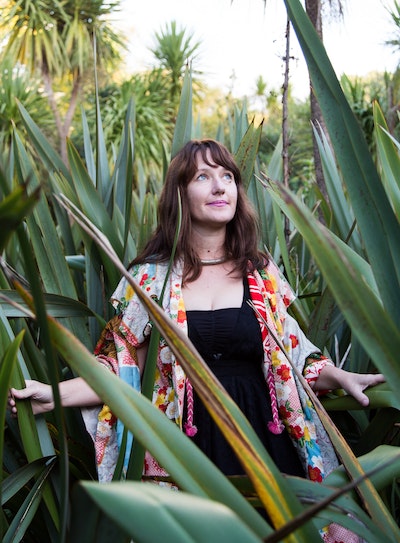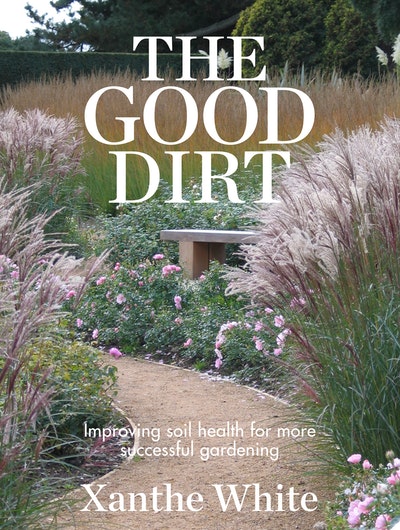Learn about the correct soil approach for your garden with landscape designer Xanthe White
If we wish to grow more, then first we must grow the soil itself. This is a process which takes time and patience, but not a lifetime; and once established the soil becomes self-producing. To understand your own soil completely, you are best to take the time to read The Good Dirt as a whole book as there are ideas throughout which will be common to all gardeners. The most important thing is to come away with an understanding that good dirt is alive and will grow of its own accord. Below is a short run-down of each of the types of soils covered in The Good Dirt, and some tips on the best way to approach each one.
When teaching people to plant in clay soils, reminding them that most of the pots we garden in are formed from clay can help to explain what not to do. A clean-cut hole in a clay soil filled with good-quality mix is akin to creating a pot beneath the surface. In winter, when water is plentiful, the hole is prone to fill with water which enjoys this vacuum, and, if no allowance has been made to help the water drain away, many plants’ roots will drown or become stressed. This is because, while most plants love water, there is a difference between sitting water and moving water.
A soil where the water is not moving is quickly identified by the smell. This should not be mistaken for the rich and heady aroma of a healthy compost, which, while it can be quite rich to the nose, is distinct from an anaerobic soil lacking in oxygen. The best description I can use is that it’s as if you have dug up some old socks – a dusty, putrid smell. Another sign of a lack of water movement in a clay soil is a greyness in colour. This environment is the same to plants as an airless room is to us. Stale air and stale earth both lack oxygen, which is as important to life beneath the surface as it is to life above.
Fertile soils are often taken for granted. The best advice is to work the soil with as little disruption as possible, and let the worms help the soil continue to grow. Constant tilling and clearing can see good soil lost at an alarmingly fast rate, especially on slopes. Leaving a soil exposed to the sun oxidises it, therefore, if you can keep the earth covered it will retain greater fertility. This fertility comes not just from the nutrient content of the soil but from the bacteria, fungi and insects that form part of a healthy earth. Interestingly, contact with this living system has been shown to increase our own immunity to disease and increase happiness. Why exactly we are still not sure, but I do know the good feelings I get from working with soil, putting my nose to the earth and feeling it through my fingers.
Continuing to mulch a soil from above will ensure that it continues to grow, as well as retain its existing structure. You should also make a conscious effort to measure what you are taking out of a soil in terms of organic matter when you prune and harvest, and then return it to the soil.
When planting, make an effort to disturb the existing structure as little as possible. Make sure that soil levels around a plant’s stem are even, but you should not need to mound or manipulate the ground other than making room for the root ball.
Gardening in this territory is like trying to snag a snapper: you need a hook and the right bait. To garden successfully you need to find a way of latching onto the organic matter and somehow creating an island of earth among soil that will otherwise be on the move. Even as you begin to create a structure in the soil – which is best created by the roots of plants – you also need a dependable supply of water and the ability to capture and best utilise this water when found.
With many sandy soils, proximity to the sea adds the further challenge of salt. Salt is capable of burning plants and is even used by some gardeners as a weedkiller, such is its toxicity. The amount of salt in a sandy soil relates not just to proximity to the coast but also to the amount of rainfall in your region. In a garden where rain is heavy and frequent, salt levels are not such an issue but salt spray from winds can still burn some plants.
Salt levels are not likely to be a problem in sandy soils that drain freely. They can become a problem with intensive irrigation of soils where the water sits only on the surface so any salts in the water build up in the top layer of soil over time. This requires an improvement in drainage to leach the salts away, which then requires more irrigation and fertiliser. Salination is quite a distinct issue to salt spray on plants in a coastal situation.
Salt at the coast can also occur near tidal estuaries. If you are unsure how exposed your garden is to salt, the best test is to identify the plants that are growing well in your local area and see how hardy they are.
Pumice is formed when frothy magna full of combustible gases cools faster than it can form a crystalline structure. This gives it two qualities which are very advantageous to gardeners. It is soft, which makes it easy for roots to push through as they grow, and it is full of air bubbles. This creates a wonderful surface in which organic matter can be captured, which is key to the development of topsoil. It is also more stable than most sands which have weathered more slowly and been polished along the way. This means the particles pack tightly in among each other, unlike coastal or river sand, which tends to easily shift with water and wind movement.
Gravel soils may be a hostile environment in which to begin a garden, but they are a great example of how landscapes can be transformed from the most extreme moonscapes to abundance. We have a wealth of experience from farmers and gardeners across the globe and across the ages to learn from. What we need to understand is that the creation of soil is a process that gardening can be a part of; and a healthy garden creates good dirt.
There is a beautiful tale told in the National Geographic of African farmers working on the edge of the Saharan desert in an environment where droughts and intensive ploughing had left the soil harder than asphalt. In this rocky environment severe famines led farmers back to traditional methods, of which one of the most successful is called cordons pierreux. It is as simple as laying lines of stones across a field. These stones need only be as large as a fist, but they create a collection point where water, finer particles of silt and then seeds collect. This creates a band of vegetation, be it grasses or low-growing perennials and shrubs, which in turn creates organic matter. Whether you view these plants as weeds or desirable plants, it’s important to understand that they’re initiating the process of a living soil formation, much in the same way as we can use flax and manuka to restore forest in New Zealand.
Water is slowed and held in this band of vegetation, which can then be replaced by trees and shrubs. They in turn create shade and shelter, which both reduce water loss, and in time these stone deserts became productive and highly valuable land.
As well as using stone above the ground to change the environment, creating pits is another technique popular in Africa. Soil pits are dug into the heavy stone and filled with manure. This is then occupied and broken down by insects and microbial activity until the rainy season, when the farmers return to plant the holes. Here in New Zealand, as well as manure, a good available source of nutrients is dead possums which can either be buried deep beneath the planting or buried ready for a later planting. When planting over organic matter such as this, you will need to mound on top of it as the earth will subside as the matter decomposes. These methods remind me of my grandmother’s vegetable garden. Her composting system involved digging a simple trench and burying the organic waste directly into this every day, pulling the soil over the top as she went. As she got to the end of a row she simply started another.
These simple stone rows are amazingly effective in precipitating life. There is no need, however, to stick to any particular line or pattern. It is the principle of using ridges and valleys that is key to success. For a natural garden, terracing with informal stone lines will create a form to capture water, as well as the ability to add organic matter to speed up the process. When you are introducing compost, planting mix or topsoil to a site, you need to consider the base you are working on. A heavier topsoil is less likely to wash through a gravel base than a finer planting mix. This can be enhanced with compost as you plant, and then mulched heavily.
Before you select a mix for the garden you are creating, you need to understand its limitations. The first thing to consider is drainage. If the water can’t escape from the container or area you are trying to plant, you run the risk of stagnation, which is a breeding ground for root diseases. Only plants that are adapted to growing in flood zones can cope with extended periods of being submerged; many plants drown and then decompose as the different microbes that thrive in these swampy conditions take over. If there is no way of draining water you need to create a cavity in the base using a depth of scoria. This depth will vary depending on the size of your container, but if you fill 10 to 20 per cent it should be sufficient. You will also need to consider the root systems of the plants you are planting. The roots will be limited by a container’s size and this will limit the growth above. In some situations this is desirable, but if you have planted a pohutakawa tree in a concrete planter, for example, it is likely that at some point its roots will slowly and gently force the pot apart as they seek new nutrients.
Drainage is essential in contained soil environments. If water cannot escape, the environment will become anaerobic and you will have problems related to this, such as soil diseases. This is one of the reasons most potting mixes, like a good loam, have some sand content. To assist drainage, one of the old tricks used by gardeners is to fill the base of the pot with broken old terracotta pots and crockery. I always put broken crockery or pottery in my compost bin. The main reason is that I know it does more good there than it would in a landfill; but I also like the idea that I’m contributing to an archaeological layer of history. In hundreds of years old Japanese Imari porcelain, English china and local earthenware may be found there.



















